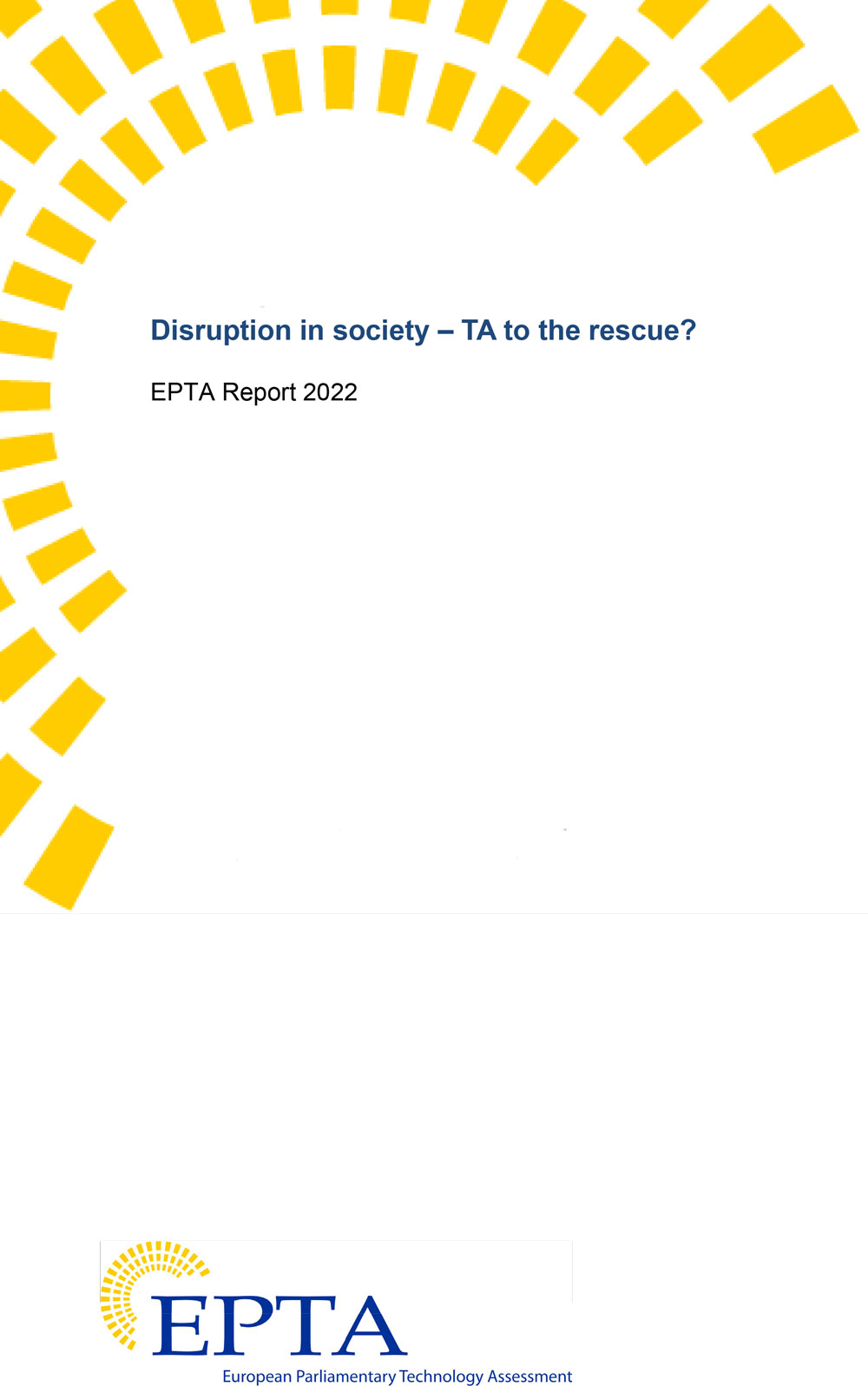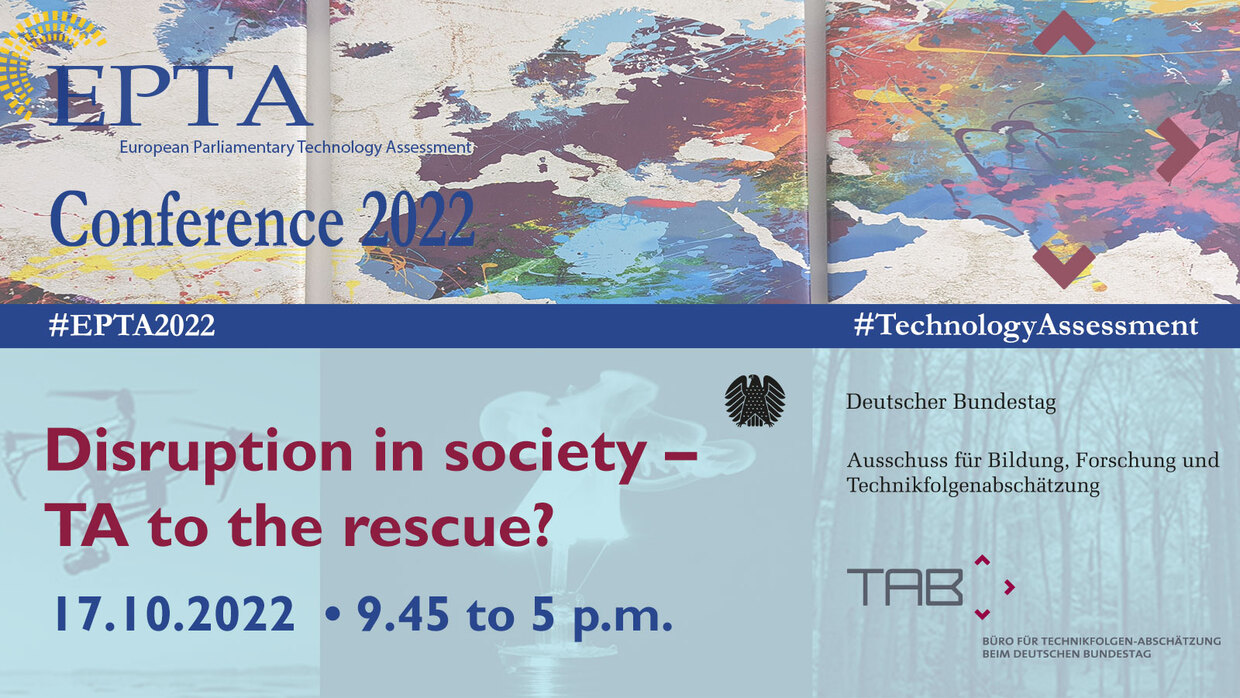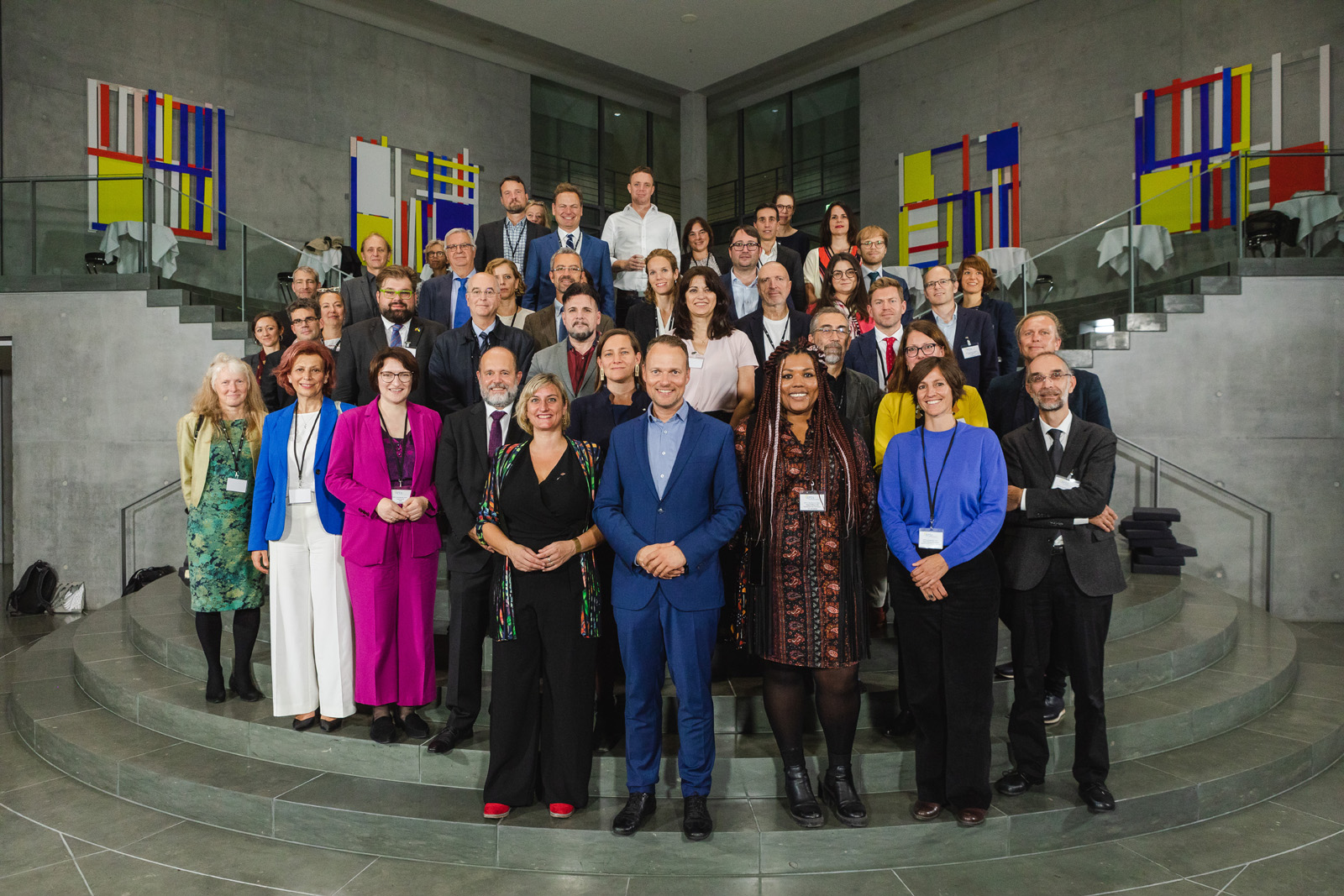Disruption in society – TA to the rescue?
-
Type of event:
Conference
-
Venue:
Deutscher Bundestag
Adele-Schreiber-Krieger-Straße 1, 10117 Berlin
Marie-Elisabeth-Lüders-Haus, Anhörungssaal 3.101 -
Date:
17.10.2022
-
Organiser:
TAB and Committee on Education, Research and Technology Assessment of the German Bundestag (as holder of this year's presidency of the network of European Parliamentary TA Institutions, EPTA).
-
Time:
9.45 bis 17.00
What do leapfrog innovations, 9/11, a possible collapse of the Gulf Stream, and the COVID-19 pandemic have in common? The answer is: disruption! What is meant here are drastic, rapidly occurring changes that are (often) destructive in nature. However, destruction can also offer opportunities for something new in the sense of "creative destruction". Relevant for technology assessment (TA) are disruptions in which technologies play an essential role, for example as a trigger of disruption, as a means of dealing with it, or as an affected system.
Using three exemplary topics, the conference highlighted some of the many facets of disruption:
- critical infrastructures (such as electricity, water supply, Internet) whose failure must be prevented at all costs;
- autonomous weapon systems as an example of software-based systems that make decisions with potentially far-reaching consequences;
- forests as a prime example of a natural area that is under severe pressure to "tip over" due to climate change and other human activities.
The aim of technology assessment is to provide orientation knowledge by identifying and naming opportunities and risks at an early stage. It can also pinpoint vulnerabilities and instabilities, develop scenarios and analyse the possible consequences of various courses of action. With numerous examples from the international research and consulting practice of the EPTA partners and beyond, the conference explored the question of what contribution TA has made and can continue to make to the political and social handling of disruptions.
We were pleased to have hosted the conference in Berlin together with the Committee on Education, Research and Technology Assessment of the German Bundestag as the holder of this year's EPTA Presidency, together with our European network partners of parliamentary TA and thank you for the numerous participation on site and in the live stream.
The EPTA network is the European association of parliamentary technology assessment institutions. The 25 members advise their respective parliaments on topics of current technologies and innovations. The annual EPTA conference in 2022 will be hosted by the German Bundestag with the Office of Technology Assessment at the German Bundestag (TAB), which holds the EPTA presidency this year.
Parallel to the conference, the EPTA Report 2022: "Disruption in society - TA to the rescue?" is published. The anthology comprises the individual contributions of network members and bundles the different perspectives on dealing with disruptions in the context of the conference themes (1) autonomous systems, (2) critical infrastructures and (3) natural areas under pressure.
Programme
| from 9:00 a.m. | Arrival and registration |
| 9:45 a.m. |
Welcome and opening
|
| 10:00 a.m. |
Thematic introduction
|
| 10:10 a.m. |
Keynote: "We shape our world, thereafter it shapes us".
|
| 10:40 a.m. |
Session I: Critical infrastructures - how do we prevent disruption? Chair:
Speaker:
|
| 12:10 p.m. | Lunch |
| 13:00 |
Session II: Autonomous weapon systems - humans in the crosshairs of the machine Chair:
Speaker:
|
| 2:30 p.m. | Coffee break |
| 3:00 p.m. |
Session III: Nature under pressure - humans as a disruptive force Chair:
Speaker:
|
| 4:30 p.m. |
Closing panel: From advice to action - Disruption from the MPs perspective Members of the TA Rapporteur Group:
Moderation:
|
| 5:00 p.m. | Refreshments |
Programme Booklet (PDF)
The conference language was in German and English and simultaneous translation was available.
Keynote: We shape our world, thereafter it shapes us
“We shape our buildings, thereafter they shape us”, Winston Churchill once stated famously. Having entered the so-called Anthropocene, this insight must be expanded to “We shape our world; thereafter it shapes us.” While events such as the failure of major infrastructures pose a threat to entire societies, the development of autonomous killer machines, or turning the planet into a hothouse have the potential to change the game fundamentally, and go far beyond “shape us”. My novels explore possible futures based on facts but guided by imagination. With the survival of humanity at stake, humanity too often gets shockingly close to fiction.
Speaker
Marc Elsberg, author of the novel "Blackout"
Session 1: Critical infrastructures - how do we prevent disruptions?
Running water, full shelves in supermarkets, medical care, cashless payments – these and other essential services have become a given in our Western societies and we are only too happy to trust that services that work today will continue to do so tomorrow. However, events such as the international financial crisis, the COVID-19 pandemic or the war of aggression in Ukraine have made visible that this feeling of security may be misleading. These and other threats (e.g. natural disasters, technical or human errors, cyberattacks) can cause sudden disruptions, damage or failure of critical systems. Given our dependency on critical services, major infrastructure failure would result in severe economic and societal disruptions.
The protection against natural hazards or manmade threats is just one of many essential tasks for operators of critical infrastructures. They also have to meet challenges such as climate change, resource scarcity, demographic change or increasing urbanization. As governments and companies worldwide invest massively in the modernization of infrastructures, sector integration (e.g. electrification of the transport sector) and digitisation are seen as key factors to meet future challenges. As a consequence, the complexity of critical systems as well as the interdependencies between them keep increasing, thereby augmenting the probability that due to cascading effects small disturbances in a subsystem result in major infrastructure and societal disruptions.
In the upcoming modernisation and transformation process the promises of technical solutions for greener, more efficient and more resilient infrastructure systems on the one hand have to be carefully balanced against the risks of failure on the other hand. How can we make critical infrastructures fit for the future without increasing the risks for massive disruptions in society? And what is the role of TA therein?
Chair
- Dr. Michael Nentwich (ITA, Austria)
Speaker
- Dr. Petra Jonvallen (ERS, Riksdag, Sweden)
- Jaro Krieger-Lamina (ITA, Austria)
- Katri Liekkilä (National Emergency Supply Agency (NESA), Finland)
- Gerhard Deimek (Member of the Austrian National Council)
Session 2: Autonomous Weapon Systems - Humans in the Crosshairs of the Machine
Autonomous systems are software-based or robotic systems that can largely independently plan and execute actions, with potentially significant consequences. In many areas, such systems will redefine the rules of the game. This is foreseeable, for example, in transportation (autonomous cars, ships, trains or airplanes) and, in the future, possibly in care for the elderly and the sick (care robotics). But pure software systems are also in use, for example in the form of algorithmic decision-making systems in finance (credit rating), human resources (applicant screening and selection) or the penal system (determining the probability of recidivism).
Autonomous Weapon Systems (AWS) are of particular concern, as they literally involve matters of life and death. Sending AWS onto the battlefield and exploiting their advantages, such as the speed with which sensor data can be analysed, without endangering the lives of their own soldiers, may sound attractive to military decision-makers. But is it politically responsible, permissible under (international) law and, not least ethically justifiable to leave the decision to use lethal force to machines?
The original task of technology assessment is to analyse the potential impacts of developing and deploying AWS and thus provide the guidance knowledge urgently needed to make these difficult trade-offs. This is a major challenge, given the dynamic nature of technological development.
Chair
- Linda Kool (Rathenau Institute, Netherlands)
Speaker
- Dr. Frank Sauer (University of the Federal Armed Forces, Munich)
- Maya Brehm (International Committee of the Red Cross, Switzerland)
- Prof. Chris Jenks, LL.M (SMU Dedman School of Law, Texas, USA)
- Prof. Dr. Cedric Ryngaert, (Utrecht University School of Law, Netherlands)
Session 3: Nature under pressure - Humans as a disruptive force
Rapidly advancing climate change, rising world population and overexploitation of natural resources are putting massive pressure on nature and its ecosystems around the globe. The age in which we live is therefore also referred to as the Anthropocene – an age in which humans are shaping the Earth on a geological scale, often with disruptive force. Global forests, as particularly sensitive, diverse ecosystems, are especially affected by this development. They are not only an important supplier of wood and thus an economic factor, but also fulfill central functions for the preservation of biodiversity and climate protection (CO2 storage).
Since ongoing climate change is likely to lead to further deterioration of the condition of forests in the future and to destabilization of forest ecosystems in the long term, the pressure to act is extremely high. However, how to make forests more resilient is currently an open question that is controversially discussed in forest science and practice. Should forest ecosystems be left largely to their own devices and forestry measures be kept to a minimum? Or is a controlled conversion of forests required instead, including new management concepts and also targeted reforestation?
The example of forests thus manifests an area of tension that also applies to other natural habitats: an intact and diverse natural environment secures existential livelihoods, but it is also an indispensable resource for many areas of the bioeconomy. The difficulty lies not only in the uncertainty regarding natural processes and tipping points, but also in the task of balancing the sometimes very different demands of the various interest groups involved (such as forest owners, timber industry, hunters, people seeking recreation). Ideally, TA succeeds in supporting this transformation, where its thinking in systemic contexts, its expertise in evaluating innovations (e.g., satellite-based monitoring), and especially its many years of experience in shaping participatory processes can be useful.
Chair
- Helene Limen (Baltic Waters 2030, Sweden)
Speaker
- Dr. Palle Madsen (InNovaSilva ApS, Denmark)
- Prof. Dr. Pierre Ibisch (HNE Eberswalde)
- Dr. Somidh Saha (ITAS, Karlsruhe)
Closing panel: From advice to action - Disruption from the perspective of MPs
TA rapporteurs in dialogue
- Kai Gehring (Chair of the Comimitee on Education, Research and Technology Assessment, Bündnis 90/Die Grünen)
- Dr. Holger Becker (SPD)
- Lars Rohwer (CDU/CSU)
- Laura Kraft (Bündnis 90/Die Grünen)
- Prof. Dr. Stephan Seiter (FDP)
- Prof. Dr.-Ing. habil. Michael Kaufmann (AfD)
- Ralph Lenkert (Die Linke)
Moderator
- Tore Tennøe (Teknologirådet, Norway)
Downloads and Links
- Programme Booklet (PDF)
- EPTA Report 2022: Disruption in society – TA to the Rescue (full report, PDF)
- EPTA Report 2022 Synthesis: Disruption in society – TA to the Rescue (synthesis, PDF)
- Press release of the Bundestag, International EPTA Conference on Societal Disruptions, 14. October (only in German).
- Review and recording of the international EPTA conference on www.bundestag.de in German as well as in English language version
- Technology assessment in times of multiple crises - more important than ever. A conference report
- Picture Gallery: Impressions from the EPTA-Konferenz
- #EPTA2022 Stories-Highlights in our Instagram Channel
- Project database of EPTA members (1985 - present)
- Policy Briefs & Reports of EPTA members (1988 - present)
- EPTA Reports (2007 - jetzt)
- Review: Shaping tomorrow's digital society. Handover of the EPTA Presidency from the Netherlands to Germany on 23.03.2022
EPTA-Report 2022
 |
|


